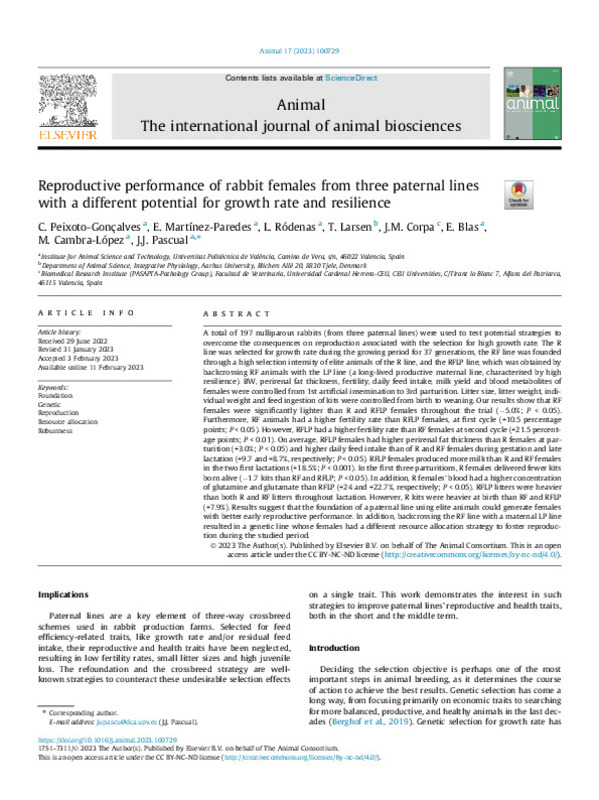JavaScript is disabled for your browser. Some features of this site may not work without it.
Buscar en RiuNet
Listar
Mi cuenta
Estadísticas
Ayuda RiuNet
Admin. UPV
Reproductive performance of rabbit females from three paternal lines with a different potential for growth rate and resilience
Mostrar el registro sencillo del ítem
Ficheros en el ítem
| dc.contributor.author | Peixoto Gonçalves, Catarina Alexandra
|
es_ES |
| dc.contributor.author | Martinez-Paredes, Eugenio
|
es_ES |
| dc.contributor.author | Ródenas Martínez, Luis
|
es_ES |
| dc.contributor.author | Larsen, T.
|
es_ES |
| dc.contributor.author | Corpa, J.M.
|
es_ES |
| dc.contributor.author | Blas Ferrer, Enrique
|
es_ES |
| dc.contributor.author | Cambra López, María
|
es_ES |
| dc.contributor.author | Pascual Amorós, Juan José
|
es_ES |
| dc.date.accessioned | 2023-12-26T19:03:03Z | |
| dc.date.available | 2023-12-26T19:03:03Z | |
| dc.date.issued | 2023-06 | es_ES |
| dc.identifier.issn | 1751-7311 | es_ES |
| dc.identifier.uri | http://hdl.handle.net/10251/201129 | |
| dc.description.abstract | [EN] A total of 197 nulliparous rabbits (from three paternal lines) were used to test potential strategies to overcome the consequences on reproduction associated with the selection for high growth rate. The R line was selected for growth rate during the growing period for 37 generations, the RF line was founded through a high selection intensity of elite animals of the R line, and the RFLP line, which was obtained by backcrossing RF animals with the LP line (a long-lived productive maternal line, characterised by high resilience). Body weight, perirenal fat thickness, fertility, daily feed intake, milk yield and blood metabolites of females were controlled from 1st artificial insemination to 3rd parturition. Litter size, litter weight, individual weight and feed ingestion of kits were controlled from birth to weaning. Our results show that RF females were significantly lighter than R and RFLP females throughout the trial (-5.0%; P<0.05). Furthermore, RF animals had a higher fertility rate than RFLP females, at first cycle (+10.5 percentage points; P<0.05). However, RFLP had a higher fertility rate than RF females at second cycle (+21.5 percentage points; P<0.01). On average, RFLP females had higher perirenal fat thickness than R females at parturition (+3.0%; P<0.05) and higher daily feed intake than of R and RF females during gestation and late lactation (+9.7% and +8.7%, respectively; P<0.05). RFLP females produced more milk than R and RF females in the two first lactations (+18.5%; P<0.001). In the first three parturitions, R females delivered fewer kits born alive (-1.7 kits than RF and RFLP; P<0.05). In addition, R females¿ blood had a higher concentration of glutamine and glutamate than RFLP (+24% and +22.7%, respectively; P<0.05). RFLP litters were heavier than both R and RF litters throughout lactation. However, R kits were heavier at birth than RF and RFLP (+7.9 %). Results suggest that the foundation of a paternal line using elite animals could generate females with better early reproductive performance. In addition, backcrossing the RF line with a maternal LP line resulted in a genetic line whose females had a different resource allocation strategy to foster reproduction during the studied period. | es_ES |
| dc.description.sponsorship | Financial support statement This study was funded by the Ministry of Science, Innovation and Universities of the Government of Spain (AGL2017-85162-C2-1-R) and the General Direction of Science and Research of the Generalitat Valenciana (AICO/2012/256) | es_ES |
| dc.language | Inglés | es_ES |
| dc.publisher | Cambridge University Press | es_ES |
| dc.relation.ispartof | Animal | es_ES |
| dc.rights | Reconocimiento - No comercial - Sin obra derivada (by-nc-nd) | es_ES |
| dc.subject | Reproduction | es_ES |
| dc.subject | Genetic | es_ES |
| dc.subject | Resources allocation | es_ES |
| dc.subject | Foundation | es_ES |
| dc.subject | Robustness | es_ES |
| dc.subject.classification | PRODUCCION ANIMAL | es_ES |
| dc.title | Reproductive performance of rabbit females from three paternal lines with a different potential for growth rate and resilience | es_ES |
| dc.type | Artículo | es_ES |
| dc.identifier.doi | 10.1016/j.animal.2023.100729 | es_ES |
| dc.relation.projectID | info:eu-repo/grantAgreement/AEI/Plan Estatal de Investigación Científica y Técnica y de Innovación 2013-2016/AGL2017-85162-C2-1-R/ES/MEJORA GENETICA DEL CONEJO DE CARNE: ESTRATEGIAS PARA INCREMENTAR LA EFICACIA DE LA MEJORA, REPRODUCCION Y SALUD DE LINEAS PATERNALES/ | es_ES |
| dc.relation.projectID | info:eu-repo/grantAgreement/GENERALITAT VALENCIANA//AICO%2F2021%2F256//Precision feeding for a sustainable rabbit production SMART-RAB/ | es_ES |
| dc.rights.accessRights | Abierto | es_ES |
| dc.contributor.affiliation | Universitat Politècnica de València. Departamento de Ciencia Animal - Departament de Ciència Animal | es_ES |
| dc.contributor.affiliation | Universitat Politècnica de València. Escuela Técnica Superior de Ingeniería Agronómica y del Medio Natural - Escola Tècnica Superior d'Enginyeria Agronòmica i del Medi Natural | es_ES |
| dc.description.bibliographicCitation | Peixoto Gonçalves, CA.; Martinez-Paredes, E.; Ródenas Martínez, L.; Larsen, T.; Corpa, J.; Blas Ferrer, E.; Cambra López, M.... (2023). Reproductive performance of rabbit females from three paternal lines with a different potential for growth rate and resilience. Animal. 17(6):1-10. https://doi.org/10.1016/j.animal.2023.100729 | es_ES |
| dc.description.accrualMethod | S | es_ES |
| dc.relation.publisherversion | https://doi.org/10.1016/j.animal.2023.100729 | es_ES |
| dc.description.upvformatpinicio | 1 | es_ES |
| dc.description.upvformatpfin | 10 | es_ES |
| dc.type.version | info:eu-repo/semantics/publishedVersion | es_ES |
| dc.description.volume | 17 | es_ES |
| dc.description.issue | 6 | es_ES |
| dc.identifier.pmid | 37167819 | es_ES |
| dc.relation.pasarela | S\483291 | es_ES |
| dc.contributor.funder | GENERALITAT VALENCIANA | es_ES |
| dc.contributor.funder | AGENCIA ESTATAL DE INVESTIGACION | es_ES |
| dc.subject.ods | 02.- Poner fin al hambre, conseguir la seguridad alimentaria y una mejor nutrición, y promover la agricultura sostenible | es_ES |








